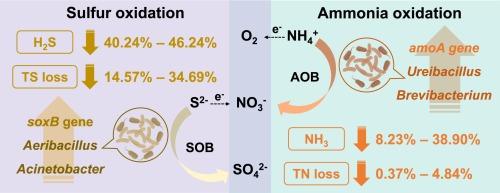堆肥过程中氨氧化对硫氧化的促进作用:硝酸盐作为桥梁
IF 7.1
2区 环境科学与生态学
Q1 ENGINEERING, ENVIRONMENTAL
引用次数: 0
摘要
氨(NH3)和硫化氢(H2S)是堆肥过程中的主要臭味成分。控制它们的排放对减少环境污染和提高堆肥产品质量非常重要。本研究通过添加氨氧化细菌(AOB,A 处理)、硫氧化细菌(SOB,S 处理)以及 AOB 和 SOB 混合菌(AS 处理),分别探讨了功能细菌对厨余垃圾(FW)堆肥过程中氮、硫代谢的影响。确定了参与氮和硫转化的关键细菌种类,并破译了堆肥过程中氨氧化推动硫氧化的内在机制。与对照处理(CK)相比,联合添加功能微生物使soxB基因丰度最大值增加了1.72倍,从而使SO42-含量增加了44.00%。AS 处理使 H2S 排放量和总硫(TS)损失量分别减少了 40.24 % 和 34.69 %,同时降低了 NH3 排放量。相关网络分析表明,同时添加 AOB 和 SOB 增强了微生物与硫氧化基因之间的相关性,不动杆菌、气杆菌、布氏杆菌和尿杆菌可能参与了氨氧化促进硫氧化的过程。总之,AOB 和 SOB 的优化接种策略可通过调节微生物群落来推动氮和硫的生物转化,最终减少臭气排放并提高硫的保存率。本文章由计算机程序翻译,如有差异,请以英文原文为准。

Promoting effect of ammonia oxidation on sulfur oxidation during composting: Nitrate as a bridge
Ammonia (NH3) and hydrogen sulfide (H2S) are the main odor components in the composting process. Controlling their emissions is very important to reduce environmental pollution and improve the quality of composting products. This study explored the effects of functional bacteria on nitrogen and sulfur metabolism in the composting process of food waste (FW) by adding ammonia-oxidizing bacteria (AOB, A treatment), sulfur-oxidizing bacteria (SOB, S treatment), and combined AOB and SOB (AS treatment), respectively. The key bacterial species involved in nitrogen and sulfur transformation were identified, and the intrinsic mechanisms by which ammonia oxidation drove sulfur oxidation during composting were deciphered. Compared with control treatment (CK), the combined addition of functional microorganisms increased the maximum of soxB gene abundance by 1.72 times, thus resulting in the increase in the SO42- content by 44.00 %. AS treatment decreased the cumulative H2S emission and total sulfur (TS) loss by 40.24 % and 34.69 %, respectively, meanwhile lowering NH3 emission. Correlation network analysis showed that the simultaneous addition of AOB and SOB enhanced the correlation between microorganisms and sulfur oxidation genes, and Acinetobacter, Aeribacillus, Brevibacterium and Ureibacillus might be involved in the ammonia oxidation-promoted sulfur oxidation process. In summary, the optimized inoculation strategy of AOB and SOB could drive biological transformation of nitrogen and sulfur by regulating microbial community, ultimately reducing odor emissions and improving sulfur conservation.
求助全文
通过发布文献求助,成功后即可免费获取论文全文。
去求助
来源期刊

Waste management
环境科学-工程:环境
CiteScore
15.60
自引率
6.20%
发文量
492
审稿时长
39 days
期刊介绍:
Waste Management is devoted to the presentation and discussion of information on solid wastes,it covers the entire lifecycle of solid. wastes.
Scope:
Addresses solid wastes in both industrialized and economically developing countries
Covers various types of solid wastes, including:
Municipal (e.g., residential, institutional, commercial, light industrial)
Agricultural
Special (e.g., C and D, healthcare, household hazardous wastes, sewage sludge)
 求助内容:
求助内容: 应助结果提醒方式:
应助结果提醒方式:


